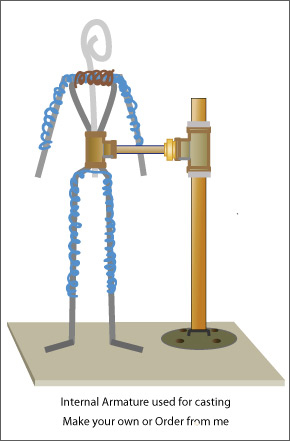Alternative to firing a clay sculpture
Dry slowly with a plastic bag hung loosely over the sculpture. Thinner areas such as ankles and arms should be covered with a dry-cleaning bag or Saran wrap, to allow the thick areas to dry at the same rate as these thinner areas. Wait until the clay is “leather hard”, that is, hard enough to handle without leaving a finger print but still damp enough to sculpt.
Using pillows, position the piece to access the bottom of a seated or reclining pose. Hollow out the piece with a spoon or sculpture rake tool so that the wall is about 1 inch thick. OR you can cut the piece in half horizontally or vertically and remove the clay. Then put together using very wet clay (called Slip) as "glue", scoring both edges of the piece for the wet clay to grab on to. Let it dry out slowly and thoroughly.
Materials:
- shellac
- denatured alcohol
- cheap paint brush suitable for the size of your piece
- a glass jar or container
- saran wrap to cover the jar
- news paper to protect surfaces
- pillow with protective covering
Start with 1/4 cup of shellac, adding the denatured alcohol until the liquid is water thin, about 50/50. The proportions will depend on the air temperature and the humidity. Use saran wrap to cover the jar in between coats. A jar lid will stick. “Paint” the mixture on the piece, going inside the hollowed-out area as far as possible. Drying time can be from 15 minutes to an hour depending on the weather. Coat 3 to 5 times.The concept is to allow the shellac to penetrate the clay and fill in the pore even with the surface.
Patina for clay or plaster
A patina can be created in several ways.
1. Japan colors (powdered oil pigment) can be used mixed with denatured alchol applied in layers, using multiple colors. This creates a feeling of depth and color variation to the patina.
2. Acrylic or oil paint
3. Clear or tinted wax or shoe polish to create dark areas combined with paint. Buff only if you want a shine.
4. Michael's carries packaged patinas.

